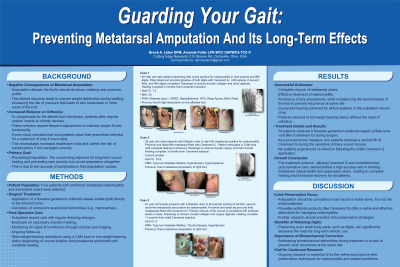Case Series/Study
(CS-048) Guarding Your Gait: Preventing Metatarsal Amputation and Its Long-term Effects
Friday, May 2, 2025
7:45 PM - 8:45 PM East Coast USA Time

Introduction: Amputation, regardless of the type, leads to long-term complications. When we change the structure of the foot, we create new pressure points that increase the risk of developing new ulcers. While inserts and orthotics can help prevent ulceration, they necessitate frequent adjustments and more regular follow-ups. Therefore, the primary goal for long-term wound healing and prevention of new wounds should be to avoid any amputation.
Methods: In this case series, we treated five patients with metatarsal ulcers who tested positive for osteomyelitis using a flowable gentamicin antibiotic-based sulfate graft* during surgical intervention. Additionally, we corrected hammertoes and other anatomical issues when necessary. After the procedure, each patient was followed up in an outpatient wound care setting for secondary healing of their ulcers.
Results: After closely monitoring these patients until their wounds were completely healed, we discovered that not only were we able to close the ulcers, but we also successfully treated the osteomyelitis, thereby avoiding the need for any amputations. All five patients healed at the outpatient wound clinic and are now able to bear full weight without the use of orthotics.
Discussion: These findings provide a promising foundation for research aimed at salvaging limbs rather than resorting to amputation as a first option. Our study demonstrated that preserving something as small as a digit can prevent the long-term requirement for orthotics. Correcting biomechanical deformities helps prevent the recurrence of ulcers at the same site. The flowable antibiotic product proved effective in clearing osteomyelitis in these cases. Further research is essential in this field, particularly regarding the long-term follow-up of these patients.
Methods: In this case series, we treated five patients with metatarsal ulcers who tested positive for osteomyelitis using a flowable gentamicin antibiotic-based sulfate graft* during surgical intervention. Additionally, we corrected hammertoes and other anatomical issues when necessary. After the procedure, each patient was followed up in an outpatient wound care setting for secondary healing of their ulcers.
Results: After closely monitoring these patients until their wounds were completely healed, we discovered that not only were we able to close the ulcers, but we also successfully treated the osteomyelitis, thereby avoiding the need for any amputations. All five patients healed at the outpatient wound clinic and are now able to bear full weight without the use of orthotics.
Discussion: These findings provide a promising foundation for research aimed at salvaging limbs rather than resorting to amputation as a first option. Our study demonstrated that preserving something as small as a digit can prevent the long-term requirement for orthotics. Correcting biomechanical deformities helps prevent the recurrence of ulcers at the same site. The flowable antibiotic product proved effective in clearing osteomyelitis in these cases. Further research is essential in this field, particularly regarding the long-term follow-up of these patients.

.jpg)